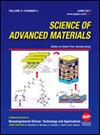Synthesis of a Tannin-Immobilized Magnetite/Graphene Oxide Composite for Magnetically Separable and Reusable Arsenic Adsorption
IF 0.9
4区 材料科学
引用次数: 0
Abstract
This study proposed a novel method to remove arsenic pollutants using a magnetically separable adsorbent based on a non-toxic biopolymer. We synthesized a tannin-immobilized magnetite/graphene oxide composite (BT–Fe3O4/GO) using tannin extracted from black tea leaves (BT) and a hydrothermal method. Various characterization methods, such as Field emission-scanning electron microscopy (FE-SEM), X-ray diffraction (XRD), Fourier transform infrared spectroscopy (FT-IR), and X-ray photoelectron spectroscopy (XPS), confirmed the successful synthesis of BT–Fe3O4/GO. The interactions involved in the synthesis were subsequently demonstrated. The maximum adsorption capacity (12.25 mg/g) of BT–Fe3O4/GO was approximately three times higher than that of Fe3O4/GO (3.487 mg/g), which indicated that tannin and Fe3O4 have synergetic adsorption affinities for As (V) ions. The adsorption performance of BT–Fe3O4/GO under acidic conditions was better than that under basic conditions. Based on the experimental results, the possible adsorption mechanisms of BT and Fe3O4 were described. The adsorption capacity of BT–Fe3O4/GO was approximately 80% of that of fresh BT–Fe3O4/GO, even after the third adsorption cycle. Moreover, it retained sufficient magnetic properties to collect the adsorbent after As adsorption. Owing to the synergetic adsorption performance of tannin and Fe3O4, tannin immobilization is a promising removal method for As ions, and BT–Fe3O4/GO is expected to be an alternative adsorbent for As remediation.单宁固定化磁铁矿/氧化石墨烯磁性可分离可重复使用砷吸附复合材料的合成
本研究提出了一种基于无毒生物聚合物的磁性可分离吸附剂去除砷污染物的新方法。以红茶中提取的单宁为原料,通过水热法制备了单宁固定化磁铁矿/氧化石墨烯复合材料(BT - fe3o4 /GO)。通过场发射扫描电镜(FE-SEM)、x射线衍射(XRD)、傅里叶变换红外光谱(FT-IR)、x射线光电子能谱(XPS)等多种表征方法证实了BT-Fe3O4 /GO的成功合成。随后证明了合成过程中所涉及的相互作用。BT-Fe3O4 /GO的最大吸附容量为12.25 mg/g,约为Fe3O4/GO的3倍(3.487 mg/g),表明单宁与Fe3O4对As (V)离子具有协同吸附亲和力。BT-Fe3O4 /GO在酸性条件下的吸附性能优于碱性条件下的吸附性能。根据实验结果,阐述了BT和Fe3O4可能的吸附机理。即使经过第三次吸附循环,BT-Fe3O4 /GO的吸附容量仍约为新鲜BT-Fe3O4 /GO的80%。此外,它还保留了足够的磁性能来收集吸附后的吸附剂。由于单宁与Fe3O4的协同吸附性能,单宁固定化是一种很有前途的As离子去除方法,BT-Fe3O4 /GO有望成为As修复的替代吸附剂。
本文章由计算机程序翻译,如有差异,请以英文原文为准。
求助全文
约1分钟内获得全文
求助全文
来源期刊

Science of Advanced Materials
NANOSCIENCE & NANOTECHNOLOGY-MATERIALS SCIENCE, MULTIDISCIPLINARY
自引率
11.10%
发文量
98
审稿时长
4.4 months
 求助内容:
求助内容: 应助结果提醒方式:
应助结果提醒方式:


